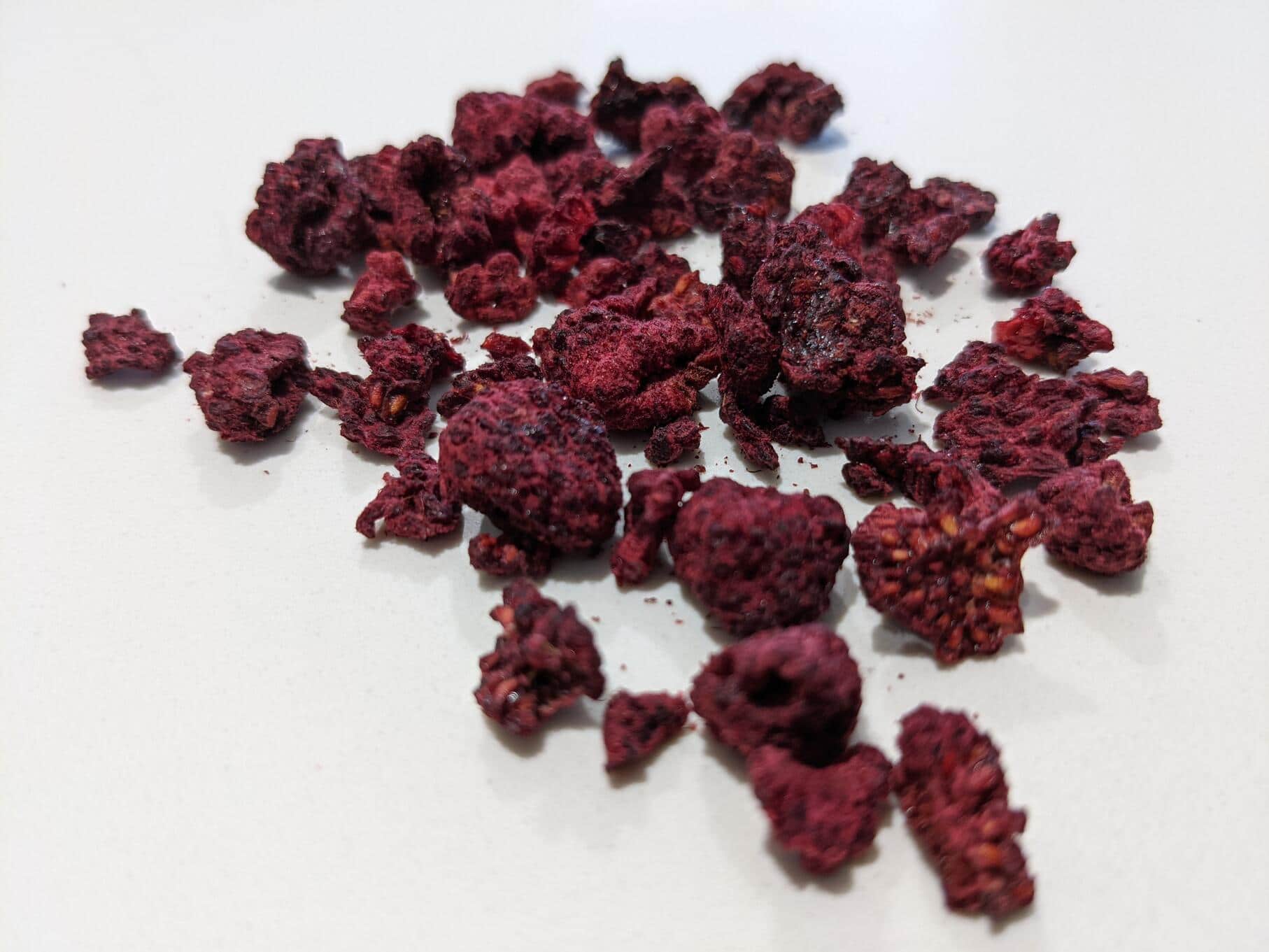How To Dry Raspberries
Important Note: When you buy through our links, we may earn a commission. As an Amazon Associate we earn from qualifying purchases. Content, pricing, offers and availability are subject to change at any time - more info.
Raspberries are known for turning moldy and mushy within just a few days of being in your fridge. This fast spoiling tends to annoy a lot of people, but there is a solution to this problem, which is to dry the raspberries. This will help the raspberries last longer if it is done correctly. So, how do you dry raspberries?
Before you begin the process of drying your raspberries, you need to prep them to ensure you only dry the right raspberries. You have multiple methods of drying to choose from, including in a dehydrator, your oven, an air fryer, or even outside in the sun, depending on the tools you have.
How exactly do you dry the raspberries using these methods? How do you prep the raspberries before you dry them? How do you correctly store your raspberries once they are dried? Let’s find out!
Methods To Dry Raspberries
Drying raspberries is a great way to keep the berries edible for longer, making them easier to store. If you dry the berries well, they can last for a few months if kept in the right conditions.
There are a few methods that you can choose from that you can use to dry your raspberries with. These methods are easy, and you can use tools that you may already have in your kitchen. But before you dry your raspberries, you need to prepare them to ensure that they get dried correctly. Se, let us see how you can prepare the raspberries and then the multiple ways you can dry them.
Prepping The Raspberries For Drying
Before you begin drying your raspberries, you need to prep them to ensure they are clean and dry correctly, which will help them last longer. Prepping the raspberries is easy and should not take much time, so let us look at how to prep them.
Step 1 – you need to ensure you are using the right kind of raspberries before you start drying them, as not all raspberries in the punnet will be suitable for drying. You need to pick out the raspberries that are overripe from the rest of the berries.
The overripe raspberries will not dry well as they are more likely to break apart during the drying process. The Raspberries that are perfect for drying are the ones that are firm to the touch and that are a bright red color.
Step 2 – wash the raspberries thoroughly in a colander or bowl and mix them around with your hands to ensure you remove any possible dirt or organisms that could be mixed with the berries.
Step 3 – Remove the raspberries from the colander or bowl and place them on some paper towels to dry off completely. Gently blot the raspberries with a different piece of paper towel until the raspberries are dry. You need to leave the raspberries to air dry for a few minutes, too; if there is any excess water on the raspberries, then the process of drying them will take longer.
Step 4 – (optional) slice the raspberries into halves as this will help them dry faster, no matter the drying method you choose to use.
Step 5 – spray the raspberries with some lemon juice to help preserve them and prevent the berries from going brown.
Now the raspberries are prepped and ready to be dried. There are a few methods that you can use to dry your raspberries. Let us go through them all so you can choose the one best suited for you.
Drying Raspberries In A Dehydrator
The first method for drying your raspberries is to use a dehydrator, which is probably one of the most effective methods to dry your raspberries. A dehydrator will slowly dry out the raspberries by pumping warm air around the raspberries and circulating it to ensure the raspberries dry simultaneously.
To ensure this drying method is effective at drying the raspberries properly, you need to arrange the raspberries on the dehydrator trays. Ensure that you space the raspberries out, with at least one inch of space between the raspberries. This will help increase proper airflow in the dehydrator and lead to better dried raspberries.
Set the dehydrate temperature of the machine to between 135 to 140 degrees Fahrenheit to dehydrate the raspberries well. You need to leave the raspberries in the dehydrator for about 10 to 15 hours. But sometimes, they may require a longer drying time, depending on the size of the raspberries or how much moisture they had on them from being washed.
But you should always check the raspberries at the ten-hour mark to ensure that they do not over dehydrate and become unpleasant to eat. To tell if your raspberries are completely dried, you can eat one of them; if the raspberries are crunchy and light, without any softness or moisture on the surface, then your raspberries are dried and ready to be enjoyed!
Drying Raspberries In The Oven
If you do not own a machine like a food dehydrator, then you are still in luck as you have a very versatile tool in your kitchen that is not only good for baking, but you can dry your raspberries in it too, your oven. Drying raspberries in your oven is relatively easy, but you might want to check that no one else needs to use the oven for a while, as this process will take a bit of time.
The first thing to do is place some parchment paper on a baking sheet and then arrange the raspberries on the baking sheet. Ensure you leave an inch of space between each raspberry to help with better air circulation around the berries in the oven, making for a better dried raspberry.
Now you can heat your oven to about 150 degrees Fahrenheit. To further help the air circulation in the oven, you can leave the oven door slightly ajar. Set a timer for six hours and keep it with you to hear it when it goes off. When this timer goes off, go and check your raspberries to see how far along they are and if you need to adjust anything.
The raspberries should be soft and bendable, which is the ideal texture if you want to use your raspberries for a topping on a cake or other pastry. But if you want to have your dried raspberries as a snack and not a cake topping, you should leave the raspberries in the oven for eight hours instead of six; this will give them a crisper texture great for snacks.
Drying Raspberries In An Air Fryer
There is another excellent tool that you may have in your kitchen that could be of great help in the quest to dry your raspberries, the humble air fryer. Some manufacturers found an ingenious way to combine a dehydrator and an air fryer into one machine, and your air fryer may be one of them.
Using this device to dry your raspberries is possible, and the results are pretty pleasing to the palette. But if you do not have one of these new air fryer and dehydrator combo, and you only have a regular air fryer, can you still dry out your raspberries with that?
It is possible to dry your raspberries in a standard air fryer. To help ensure the process goes smoothly and that your raspberries do not burn in the air fryer, you need to set the machine to the lowest heat setting. The lowest heat setting is generally around 150 to 200 degrees Fahrenheit, perfect for low heat drying your raspberries.
Place the raspberries on the racks in the air fryer with one inch of space between each raspberry to help improve the air circulation in the air fryer while the raspberries are drying out. Set the timer that is on your air fryer for 15 minutes, but you will need to check the raspberries every five minutes to help avoid burning the raspberries. You can repeat this until the raspberries are at your desired texture.
Drying Raspberries In The Sun
If you do not have any of the machines mentioned above or you do not want to take over the oven for six to eight hours, you can go the more natural and traditional route to dry your raspberries; you can dry them in the sun. This drying method is perfect for the summer, but if you reside in an area that has plenty of sunshine year-round, then you can use this method in just about any season.
Before you start this method, you need to find a good place outside to lay your raspberries in; this can be your backyard, your concrete front yard, or even your roof deck. You need to find a location that has good air circulation, that is in direct sunlight, and that is protected from insects and bugs that may try and eat the berries.
To help make sure your raspberries dry correctly, the minimum temperature outside where you are drying the berries needs to be around 85 degrees Fahrenheit. The humidity level should be less than 60%. But the higher the temperature is, the better, as it will dry your raspberries out faster.
You can easily make a drying rack for your raspberries out of tin or aluminum, but if you have baking sheets, you can use them too. Arrange the raspberries on the drying rack, with one inch of space between them, and cover the berries with cheesecloth to protect them from dust or other pollutants that may fall on the raspberries.
Then take your berries to the place in your garden that you choose and lay them there to dry out. This method will take several days to dry out the raspberries, but you need to check them every day to ensure everything is going well. This is the most eco-friendly method of drying your raspberries.
How To Store Dried Raspberries
Now that you have dried your raspberries into lovely snacks for later, you need to know how to store your dried raspberries, so they do not spoil or begin to grow mold before you get the opportunity to enjoy your raspberries.
Once the berries are dried out, you need to wait for them to cool down completely before you try and store them. When the raspberries are still warm, the air that surrounds them holds a good amount of moisture, and if you keep your raspberries in this condition, the moisture will form condensation inside the container. This will decrease the dried raspberries’ shelf life.
Once the raspberries have cooled down, you need to condition them before placing them into containers for storage. To do this, you need to pace the raspberries into a clean jar, do not pack them in tightly, leave room for them to move.
Keep the raspberries in the jar for between 7 to 10 days and shake the jar at least once a day. If you notice any condensation in the jar during this process, then you need to repeat the method you used to dry the raspberries to dry them out more.
Once this process is done and you are confident the raspberries are void of moisture, you can now store the berries. The dried raspberries need to be kept in freezer bags or air-tight containers, or you can use a jar that offers an air-tight seal.
Do not store your dried raspberries in standard sandwich bags; you need to use freezer bags as they are thicker and protect the berries more. You must remove the air from the freezer bags before you seal them to help prevent any moisture from the air from getting to the dried raspberries.
This moisture can cause the raspberries to grow mold. It is best to store your dried raspberries in small batches as this helps maintain the berries’ freshness and reduces the risk of contamination of all your raspberries if something happens.
Storing them in smaller batches also lets you avoid opening and closing the container or bag whenever you want your raspberries, which allows air into the container and can cause moisture to build up. This can lead to the raspberries growing mold.
Label each container with the date, so you know when you made them and keep them in a dark, dry, and cool location, or you can store them in your freezer.
There are multiple ways to dry your raspberries at home, and you do not need a fancy piece of equipment for the process if you do not have one. Drying the raspberries will take a while with most of the methods mentioned above, so you just need to ensure you have the time to keep an eye on your raspberries throughout the process. Enjoy your dried raspberries!
























